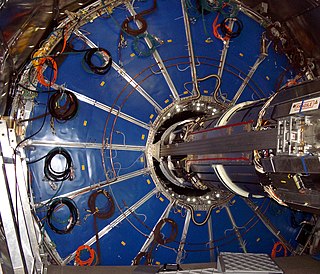Weakly interacting massive particles (WIMPs) are hypothetical particles that are one of the proposed candidates for dark matter.

A scintillator is a material that exhibits scintillation, the property of luminescence, when excited by ionizing radiation. Luminescent materials, when struck by an incoming particle, absorb its energy and scintillate. Sometimes, the excited state is metastable, so the relaxation back down from the excited state to lower states is delayed. The process then corresponds to one of two phenomena: delayed fluorescence or phosphorescence. The correspondence depends on the type of transition and hence the wavelength of the emitted optical photon.

Neutrino oscillation is a quantum mechanical phenomenon in which a neutrino created with a specific lepton family number can later be measured to have a different lepton family number. The probability of measuring a particular flavor for a neutrino varies between three known states, as it propagates through space.

In physics, a time projection chamber (TPC) is a type of particle detector that uses a combination of electric fields and magnetic fields together with a sensitive volume of gas or liquid to perform a three-dimensional reconstruction of a particle trajectory or interaction.
The Liquid Scintillator Neutrino Detector (LSND) was a scintillation counter at Los Alamos National Laboratory that measured the number of neutrinos being produced by an accelerator neutrino source. The LSND project was created to look for evidence of neutrino oscillation, and its results conflict with the standard model expectation of only three neutrino flavors, when considered in the context of other solar and atmospheric neutrino oscillation experiments. Cosmological data bound the mass of the sterile neutrino to ms < 0.26eV (0.44eV) at 95% (99.9%) confidence limit, excluding at high significance the sterile neutrino hypothesis as an explanation of the LSND anomaly. The controversial LSND result was tested by the MiniBooNE experiment at Fermilab which has found similar evidence for oscillations. The hint is currently undergoing further tests at MicroBooNE at Fermilab.

In nuclear physics, double beta decay is a type of radioactive decay in which two neutrons are simultaneously transformed into two protons, or vice versa, inside an atomic nucleus. As in single beta decay, this process allows the atom to move closer to the optimal ratio of protons and neutrons. As a result of this transformation, the nucleus emits two detectable beta particles, which are electrons or positrons.

The neutrinoless double beta decay (0νββ) is a commonly proposed and experimentally pursued theoretical radioactive decay process that would prove a Majorana nature of the neutrino particle. To this day, it has not been found.

MiniBooNE is a Cherenkov detector experiment at Fermilab designed to observe neutrino oscillations. A neutrino beam consisting primarily of muon neutrinos is directed at a detector filled with 800 tons of mineral oil and lined with 1,280 photomultiplier tubes. An excess of electron neutrino events in the detector would support the neutrino oscillation interpretation of the LSND result.

Neutron detection is the effective detection of neutrons entering a well-positioned detector. There are two key aspects to effective neutron detection: hardware and software. Detection hardware refers to the kind of neutron detector used and to the electronics used in the detection setup. Further, the hardware setup also defines key experimental parameters, such as source-detector distance, solid angle and detector shielding. Detection software consists of analysis tools that perform tasks such as graphical analysis to measure the number and energies of neutrons striking the detector.
Cadmium tungstate (CdWO4 or CWO), the cadmium salt of tungstic acid, is a dense, chemically inert solid which is used as a scintillation crystal to detect gamma rays. It has density of 7.9 g/cm3 and melting point of 1325 °C. It is toxic if inhaled or swallowed. Its crystals are transparent, colorless, with slight yellow tint. It is odorless. Its CAS number is 7790-85-4. It is not hygroscopic.

SNO+ is a physics experiment designed to search for neutrinoless double beta decay, with secondary measurements of proton–electron–proton (pep) solar neutrinos, geoneutrinos from radioactive decays in the Earth, and reactor neutrinos. It is under construction using the underground equipment already installed for the former Sudbury Neutrino Observatory (SNO) experiment at SNOLAB. It could also observe supernovae neutrinos if a supernova occurs in our galaxy.

DEAP is a direct dark matter search experiment which uses liquid argon as a target material. DEAP utilizes background discrimination based on the characteristic scintillation pulse-shape of argon. A first-generation detector (DEAP-1) with a 7 kg target mass was operated at Queen's University to test the performance of pulse-shape discrimination at low recoil energies in liquid argon. DEAP-1 was then moved to SNOLAB, 2 km below Earth's surface, in October 2007 and collected data into 2011.

Borexino is a particle physics experiment to study low energy (sub-MeV) solar neutrinos. The detector is the world's most radio-pure liquid scintillator calorimeter. The scintillator is pseudocumene and PPO which is held in place by a thin nylon sphere. It is placed within a stainless steel sphere which holds the photomultiplier tubes (PMTs) used as signal detectors and is shielded by a water tank to protect it against external radiation. Outward pointing PMT's look for any outward facing light flashes to tag incoming cosmic muons that manage to penetrate the overburden of the mountain above. Neutrino energy can be determined through the number of photoelectrons measured in the PMT's. While the position can be determined by extrapolating the difference in arrival times of photons at PMT's throughout the chamber.
Lorentz-violating neutrino oscillation refers to the quantum phenomenon of neutrino oscillations described in a framework that allows the breakdown of Lorentz invariance. Today, neutrino oscillation or change of one type of neutrino into another is an experimentally verified fact; however, the details of the underlying theory responsible for these processes remain an open issue and an active field of study. The conventional model of neutrino oscillations assumes that neutrinos are massive, which provides a successful description of a wide variety of experiments; however, there are a few oscillation signals that cannot be accommodated within this model, which motivates the study of other descriptions. In a theory with Lorentz violation, neutrinos can oscillate with and without masses and many other novel effects described below appear. The generalization of the theory by incorporating Lorentz violation has shown to provide alternative scenarios to explain all the established experimental data through the construction of global models.

Double Chooz was a short-baseline neutrino oscillation experiment in Chooz, France. Its goal was to measure or set a limit on the θ13 mixing angle, a neutrino oscillation parameter responsible for changing electron neutrinos into other neutrinos. The experiment uses reactors of the Chooz Nuclear Power Plant as a neutrino source and measures the flux of neutrinos they receive. To accomplish this, Double Chooz has a set of two detectors situated 400 meters and 1050 meters from the reactors. Double Chooz was a successor to the Chooz experiment; one of its detectors occupies the same site as its predecessor. Until January 2015 all data has been collected using only the far detector. The near detector was completed in September 2014, after construction delays, and started taking data at the beginning of 2015. Both detectors stopped taking data in late December 2017.

Antonio Ereditato is an Italian physicist, currently associate researcher at Fermilab, Batavia, USA, and Emeritus professor at the University of Bern, Switzerland, where he has been Director of the Laboratory for High Energy Physics from 2006 to 2020. From 2021 to 2022 he has been Visiting Professor at the Yale University, USA. He carried out research activities in the field of experimental neutrino physics, of weak interactions and strong interactions with experiments conducted at CERN, in Japan, at Fermilab in United States and at the LNGS in Italy. Ereditato has accomplished several R&D studies on particle detectors: wire chambers, calorimeters, time projection chambers, nuclear emulsions, detectors for medical applications.
The Nucifer Experiment is a proposed test of equipment and methodologies for using neutrino detection for the monitoring of nuclear reactor activity and the assessment of the isotopic composition of reactor fuels for non-proliferation treaty compliance monitoring. Based upon an idea proposed by L.A. Mikaélyan in 1977, the Nucifer Experiment was proposed to the IAEA in October 2008.
A geoneutrino is a neutrino or antineutrino emitted in decay of radionuclide naturally occurring in the Earth. Neutrinos, the lightest of the known subatomic particles, lack measurable electromagnetic properties and interact only via the weak nuclear force when ignoring gravity. Matter is virtually transparent to neutrinos and consequently they travel, unimpeded, at near light speed through the Earth from their point of emission. Collectively, geoneutrinos carry integrated information about the abundances of their radioactive sources inside the Earth. A major objective of the emerging field of neutrino geophysics involves extracting geologically useful information from geoneutrino measurements. Analysts from the Borexino collaboration have been able to get to 53 events of neutrinos originating from the interior of the Earth.
The STEREO experiment investigates the possible oscillation of neutrinos from a nuclear reactor into light so-called sterile neutrinos. It is located at the Institut Laue–Langevin (ILL) in Grenoble, France. The experiment started operating and taking data in November 2016.
Supernova neutrinos are weakly interactive elementary particles produced during a core-collapse supernova explosion. A massive star collapses at the end of its life, emitting on the order of 1058 neutrinos and antineutrinos in all lepton flavors. The luminosity of different neutrino and antineutrino species are roughly the same. They carry away about 99% of the gravitational energy of the dying star as a burst lasting tens of seconds. The typical supernova neutrino energies are 10–20 MeV. Supernovae are considered the strongest and most frequent source of cosmic neutrinos in the MeV energy range.











